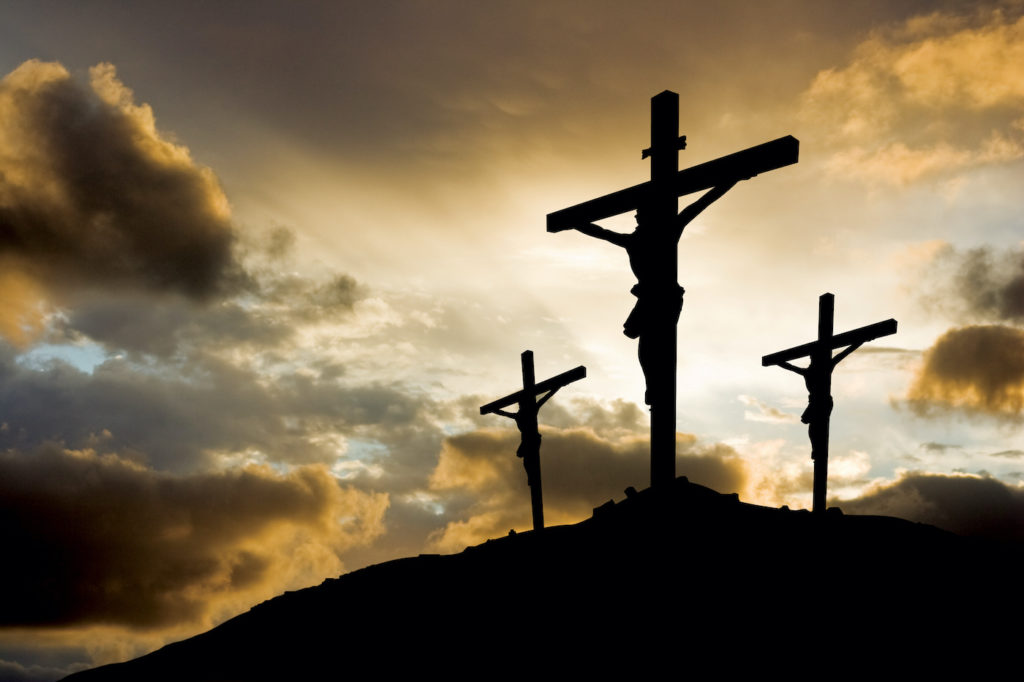When I began writing this column two years ago, it was first on a weekly and then on a biweekly basis during the early Covid-19 lockdowns, under the title “Isolation Bookshelf,” with the occasional foray into the movies under the title “Isolation Cinema.” Since the column became a monthly feature as simply “The Bookshelf” in late 2020, I have written only a couple of times about films, and then only in connection with the books (or plays) on which they were based. Somehow “The Cinema” doesn’t work as a column title!
But I take this occasion to write about movies during Holy Week, at the prompting of an old friend and faithful reader, who wondered about my thoughts on the cinematic presentation of Jesus. His query took my mind back to my boyhood in the 1960s and ’70s, when television networks, around the time of Passover and Easter, would broadcast the epic 1950s films The Ten Commandments and Ben-Hur. (This is still a regular part of the calendar: ABC broadcast The Ten Commandments on the eve of Palm Sunday this year.)
These classic films, both starring Charlton Heston in the leading roles, were but two leading examples of an extraordinary run of movies based on biblical and Christian stories that Hollywood made in a roughly twenty-year period after the Second World War. Biblical and quasi-biblical epics became such a studio staple during this era that the Coen brothers, whose love for Hollywood history is well known, good-naturedly mocked the genre in their 2016 movie Hail, Caesar! But what was it about the postwar period that prompted the studios to crank out these sword-and-sandal religious films?
Cecil B. DeMille, who had earlier bridged the silent-to-talkies era with his trio of religious films The Ten Commandments (1923), The King of Kings (1927), and The Sign of the Cross (1932), brought the genre roaring back with Samson and Delilah, which was released in December 1949 and became the highest-grossing film of 1950. Elaborating the Bible’s brief story of Samson into more than two hours, DeMille gave moviegoers a Technicolor extravaganza of scantily dressed beefcake (Victor Mature as Samson) and cheesecake (Hedy Lamarr as Delilah). DeMille had combined solemn piety with sex appeal before: In The Sign of the Cross, he had Claudette Colbert play the Roman empress Poppaea bathing in an enormous vat of putative asses’ milk, which prompted the creation of the Catholic Legion of Decency and hastened the arrival of the Hays Code by which Hollywood policed itself.
Start your day with Public Discourse
Sign up and get our daily essays sent straight to your inbox.The success of Samson and Delilah led in short order to 1951’s David and Bathsheba, a modestly successful Henry King film likewise in color, starring Gregory Peck and Susan Hayward in the title roles—and likewise expanding and taking liberties with a tale told briefly in the Bible. The same year also brought an adaptation of Henryk Sienkiewicz’s 1896 novel Quo Vadis, set in the Rome of Nero (as was The Sign of the Cross, itself based on an 1895 play). Directed by Mervyn LeRoy and starring Robert Taylor and Deborah Kerr, Quo Vadis was a huge hit, and was nominated for best picture at the Academy Awards.
After the triumphs of Samson and Delilah and Quo Vadis, Hollywood began to crank out more and more such films—some, like Samson, based on stories from Scripture; others, like Quo Vadis, based on novels about the early years of Christianity. And beginning with The Robe (1953), based on a 1942 novel by Lloyd C. Douglas, these epics were not only in color but in widescreen formats like Cinemascope. For sheer spectacle—big budget, big screen, bright colors—they offered something moviegoers just couldn’t see on their tiny black-and-white televisions at home. The Robe, which starred Richard Burton and Jean Simmons, even prompted an epic-length 1954 sequel, Demetrius and the Gladiators, with their co-star Victor Mature (again!) joined by Susan Hayward (again!)
What was going on here? After the horrors of World War II, was there an increase in religious devotion that prompted the making of these films? The late Alan Petigny, in The Permissive Society: America, 1941–1965 (2009), challenged what he called the “standard historical narrative” of the 1950s as “a time of religious revival.” It was not, he argued, “an age of intensified religious belief.” But it was, Petigny claimed, a period that witnessed the “dulling of sectarian differences and, concomitantly, the rise of explicit interfaith cooperation.” Interfaith marriages were on the rise, the Christian impulse to proselytize their Jewish fellow citizens was being progressively abandoned, and Americans were generally becoming more inclined toward toleration, pluralism, and a live-and-let-live prizing of one another’s religious freedom. These are in many respects very real goods in a society with a multiplicity of religious sects. If they came at some cost in the “secularizing” of American public life, as Petigny argues, that is unfortunate; but it does not make them evils in themselves.
Hollywood’s contribution to these changes in American society can be seen in these “religious epic” movies of the postwar period. A bit of fairly harmless titillation was often a standard feature, à la DeMille, in now forgotten films that served as late star turns for the previous decade’s sex symbols, such as Rita Hayworth’s Salome (1953) and Lana Turner’s The Prodigal (1955), or pushed the careers of newer European starlets to American audiences, such as Anouk Aimée in 1962’s Sodom and Gomorrah (a fairly preposterous presentation of the Genesis tale of debauchery, perversion, and the wrath of God), and Gina Lollobrigida in 1959’s Solomon and Sheba (a dud that marked a sad end to the career of the great director King Vidor).
As for the piety, it came in small, easily digestible doses. The Hebrews of the Old Testament stories were presented chiefly as lovers of the freedom to worship their one God—freedom from the Egyptians or the Philistines, as the case may be. One could hardly miss the Cold War message in the prologue to DeMille’s 1956 The Ten Commandments, in which the director himself appeared on screen and called it “the story of the birth of freedom,” going on to say, “The theme of this picture is whether men are to be ruled by God’s law or whether they are to be ruled by the whims of a dictator like Rameses. Are men the property of the state, or are they free souls under God? This same battle continues throughout the world today.” An important message, to be sure, but hardly all there is to say about the relationship of the chosen people to the Almighty. DeMille’s story of Moses—much of it based on a modern novel, not on Exodus—compressed the forty years in the wilderness into the last few minutes. Nonetheless, his final film won the Oscar for best picture, and it has its undeniable thrills and grandeur.
In short, the Hollywood religious-epic genre of this period was all about uplift, and toleration, and offending exactly no one.
As for the early Christians in films like Quo Vadis and The Robe, they are presented as noble, humble, courageous, forbearing, and above all nice people, especially compared to the invariably cynical, worldly Romans. The Christians’ simple faith in a wonder-working carpenter from Nazareth is touching, but one hardly gets a very firm sense of Jesus’s hard teachings or of the shocks that their new faith inflicted on the ancient world. And the conversions of the pagan protagonists of these films seem hardly credible, so easily and suddenly do they finally sacrifice a lifetime’s habits and beliefs to face oppression and even death with their new co-religionists.
The nadir of this sub-genre is 1954’s The Silver Chalice, based on a 1952 Thomas B. Costain novel, in which Paul Newman, in his first film, turns in a perfectly lifeless performance, his dullness surpassed only by the strangely modernist sets and production designs, which made the story as remote from history as Newman’s young Greek sculptor was from any genuine religious experience. (This movie was a perennial embarrassment for its star, who in 1966, when it was shown on TV for the first time, placed a large ad in Variety urging people not to watch it.)
In short, the Hollywood religious-epic genre of this period was all about uplift, and toleration, and offending exactly no one. And if scripture, or the life of the early Church, did not seem to provide enough excitement to sustain a feature-length film, then a little sexual tension, or some heroic action scenes (battles, gladiatorial combat, chariot races) would serve the turn.
But what about Jesus himself in these films, my friend is now asking—how does our Lord appear in the flickering image of cinema? To answer, we might look at the best of the period’s religious epics, William Wyler’s Ben-Hur (1959), which won eleven Oscars, including best picture, director, and actor. Like The Ten Commandments, the picture rests all its weight on the sturdy shoulders of Charlton Heston, whose character’s suffering and revenge culminate in a cathartic vanquishing of his nemesis in the famous chariot race—before he takes on board the gospel of forgiveness taught by Jesus. Only the last half hour or so of this three-and-a-half hour epic concentrates on Judah Ben-Hur’s encounter with Christ during his Passion. (Fred Niblo’s 1925 silent version, Ben-Hur: A Tale of the Christ, starring Ramon Navarro, hewed more closely to Lew Wallace’s 1880 novel, and was thus more steadily religious throughout.)
Ben-Hur gives us another standard feature of these epics, shared with Quo Vadis and The Robe: we never see the face of Jesus Christ. Whether out of reverence, or the impulse to offend no one, or fear of failure to convey what the second Person of the Trinity should look like, Hollywood habitually trained its cameras on Jesus from behind or the side, but never head-on. (This is hilariously spoofed in Hail, Caesar!)
As entertaining as the religious-epic genre had been at its best, it proved finally to be as anodyne as Brotherhood Week, another postwar contribution to America’s tolerant pluralism.
In the silent era, DeMille’s The King of Kings had told the story of the gospels straightforwardly, with Jesus the central character, and this 1927 film is still worth watching for H. B. Warner’s humanly approachable, dignified, and affecting portrayal of Christ. No one placed Jesus at the center of his own story again until Nicholas Ray made King of Kings in 1961. Unfortunately, Jeffrey Hunter’s performance as Jesus was strangely inert. It was as though everyone concerned in making the movie was handling the material with ten-foot tongs, keeping their distance. This may be what comes of pursuing the project of inoffensive uplift, which fails to do justice to a truly explosive subject.
So too The Greatest Story Ever Told (1965), by director George Stevens, was a four-hour failure, despite a game effort by Max von Sydow as Jesus, and an all-star cast in other roles large and small—including Charlton Heston (again!) as John the Baptist. The Greatest Story managed to make the gospels tedious, thanks to the director’s decision to pace the film as though every moment in the life of Jesus had to be posed as a tableau for fresco painters.
Stevens’s epic flop brought an era to an end. As entertaining as the religious-epic genre had been at its best, it proved finally to be as anodyne as Brotherhood Week, another postwar contribution to America’s tolerant pluralism. And it played itself out most disappointingly when Hollywood placed Jesus at the center of the story rather than the periphery. Not until Mel Gibson made The Passion of the Christ four decades later would a major Hollywood figure take a chance on a straightforward retelling of the gospel story. (I leave aside Martin Scorsese’s 1988 The Last Temptation of Christ, a kind of anti-gospel based instead on a Nicholas Kazantzakis novel.) Gibson’s film came in for much criticism, including charges of anti-Semitism that sometimes seemed to be more about the director than the movie. But his excruciating depiction of the Passion, to his credit, had nothing at all to do with the feel-good uplift of the postwar religious epics. It is still a very hard film to watch, and it is not for everyone.
So far, the low-budget, crowd-funded television series The Chosen has, in my opinion, brought us the most appealing depiction of Jesus since H. B. Warner played the part in 1927. It remains to be seen how the story will be told as the climactic Passion and Resurrection arrive. What is promising, however, is that the project of mere uplift seems to be consigned to the past, where it belongs.














